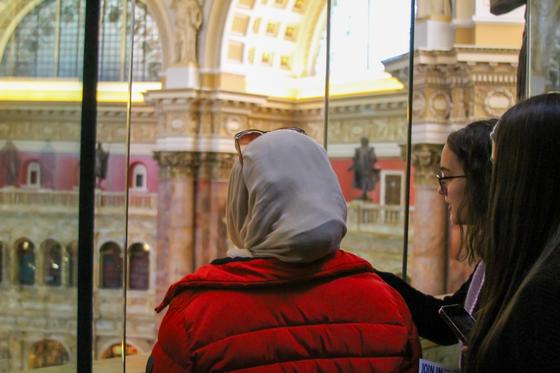The Library of Congress is the largest library in the world, its collections encompassing more than 175 million items. And it sits less than 30 minutes from George Mason’s campus. On February 17, Honors College students were given the opportunity to discover for themselves this bastion of American culture.
During the visit, the students were able to see some of the Library of Congress’ most significant exhibitions and collection pieces – including a replica of Thomas Jefferson’s personal library, whose books are part of the Rare Book and Special Collections Division. Jefferson’s library comprised over six thousand volumes on politics, history and science. A selection of these books is encased in the display. As the group walked around, they admired the wide variety of literature Jefferson exposed himself to as well as the authors and titles that shaped his thinking.
“Seeing what topics Thomas Jefferson had read and the influential authors he was inspired by was intriguing. His books about botany also surprised me.”
Among the special collection pieces on display is a Guttenberg Bible, one of the earliest books to be printed using mass-produced movable metal type. The Library of Congress’s copy is printed on vellum – thin parchment made from animal skin – and is one of only three complete vellum copies that survive today. This artifact's historical significance and its contribution to the dissemination of knowledge continue to remind the Honors College students, and all visitors, of the transformative power of information that the library represents.

As the students’ tour continued, the group climbed the stairs to the observation deck to view the Main Reading Room below. While floor access is restricted to researchers, the panoramic view from the balcony gave them a glimpse of the gravitas of the space. The mission of a library and its contents can be seen in the building's architecture. According to the Library of Congress, the eight large statues that circle the reading room each represent a category of knowledge understood to symbolize aspects of civilized life and thought: philosophy, art, history, commerce, religion, science, law and poetry.
The Library of Congress began as a small resource for the use of Congress. Lost in a fire during the War of 1812, Thomas Jefferson offered to sell his personal library to replace the library’s collections, from which its contents have only grown. The main building, with its recognizable façade, officially opened to the public in 1897. Since then, the Library of Congress has been on the forefront of modernization, pioneering digital library catalogues in partnership with UNESCO, among other innovations.
The Honors College strives to offer a well-rounded education to its students, promoting their intellectual and cultural development though various thoughtfully selected events. Keep an eye on the weekly newsletter for new opportunities to join Honors College trips.
